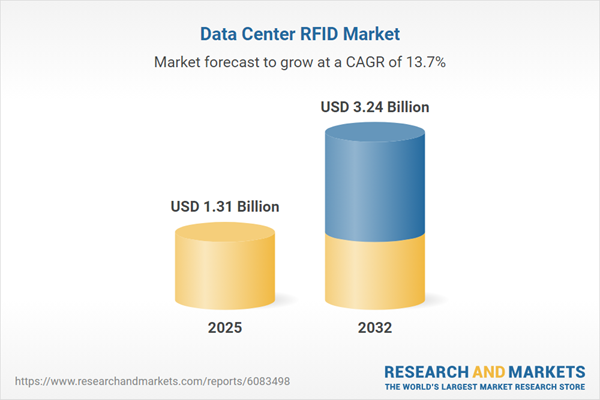Speak directly to the analyst to clarify any post sales queries you may have.
The data center RFID market is evolving rapidly as senior decision-makers seek advanced solutions for asset management, operational continuity, and regulatory compliance. Implementing RFID enables organizations to drive intelligent automation and robust security throughout their digital infrastructure.
Market Snapshot: Data Center RFID Market Growth and Outlook
The data center RFID market is on a strong growth trajectory, having increased from USD 1.16 billion in 2024 to USD 1.31 billion in 2025, with projections indicating a rise to USD 3.24 billion by 2032 and a compound annual growth rate (CAGR) of 13.72%. This expansion is powered by accelerated adoption of cloud and edge computing, stricter compliance obligations, and the pressing demand for transparency across complex digital infrastructures. The shift towards automation continues to reduce manual intervention, minimize errors, and support uninterrupted operations in mission-critical data center environments.
Scope & Segmentation of the Data Center RFID Market
This in-depth research offers clear market segmentation, providing strategic insight for effective RFID investment planning across global data center operations.
- Technology: RFID deployments include high-frequency, low-frequency, and ultra-high-frequency options, each suited for unique operational sensitivities and workflow requirements in data centers.
- Offering: The ecosystem encompasses antennas, tags, readers, software for specialized applications, middleware, system integration, and ongoing maintenance services.
- Application: RFID solutions drive asset tracking to enhance accountability, real-time environmental monitoring, streamlined inventory management, personnel tracking, and integrated security with access management features.
- End User: Core industries adopting RFID in data centers include banking and financial services, healthcare, IT and telecom, manufacturing, and retail. Each brings distinct security and operational requirements to the RFID landscape.
- Deployment: Organizations select between cloud-based and on-premises models. These choices equip them with scalable solutions and integration capabilities aligned with existing enterprise systems.
- Regional Coverage: Market activity spans the Americas, Europe, the Middle East, Africa, and Asia-Pacific. Regional adoption patterns reflect diverse regulatory demands and technological readiness.
- Company Profiles: Leading RFID providers include Impinj, Inc.; Zebra Technologies Corporation; NXP Semiconductors N.V.; Avery Dennison Corporation; Alien Technology Corporation; Honeywell International Inc.; HID Global Corporation; Checkpoint Systems, Inc.; SATO Holdings Corporation; and Trimble Inc. Their diverse solution portfolios and innovation priorities shape a highly competitive market environment.
Key Takeaways for RFID Strategy Leaders
- Advanced RFID solutions enable proactive maintenance by delivering continuous asset monitoring and supporting speedy incident resolution, fostering greater operational stability.
- When combined with analytics and machine learning, RFID data allows organizations to anticipate hardware issues and strategically allocate resources.
- Automated processes utilizing RFID technology decrease manual effort, helping maintain compliance and enforce internal policies in complex settings.
- As interoperability and privacy standards expand globally, organizations must evaluate the cross-regional compatibility and electromagnetic compliance of RFID deployments during planning.
- Sustainable procurement is gaining importance, with organizations investing in RFID components that support long-term data center sustainability objectives.
- Flexible vendor relationships and modular analytics platforms provide organizations the ability to scale while reducing the risk of vendor lock-in with RFID infrastructure.
Tariff Impact: Adapting Procurement for Data Center RFID
Evolving U.S. tariffs on imported RFID components have prompted supply chain diversification within the sector. Senior leaders are responding by adopting dual-sourcing strategies and favoring localized procurement to improve continuity and manage total cost of ownership. Embracing just-in-time inventory and collaborative purchasing increasingly supports resilient supply chains, efficient cost control, and adaptive hardware availability in a shifting regulatory landscape.
Methodology & Data Sources
This research draws upon comprehensive secondary analysis, targeted expert interviews, scenario modeling, and peer review to validate findings. Subject matter expert input and independent triangulation enhance the credibility and depth of the report’s analytical foundation.
Why This Report Matters for RFID Stakeholders
- Guides organizations in aligning RFID investments with core digital transformation and evolving compliance strategies, strengthening overall organizational preparedness.
- Delivers actionable segmentation insights, enabling leaders to adapt RFID technology, deployment, and procurement to specific operational and regional objectives.
- Enables risk assessment by evaluating supply chain, regulatory, and interoperability trends shaping the direction of data center RFID adoption.
Conclusion
RFID technology is central to achieving resilient, adaptive, and sustainable operations in modern data centers. Insights from this report equip senior leaders to secure full asset transparency, boost compliance, and drive agility amid rapid technological change.
Table of Contents
3. Executive Summary
4. Market Overview
7. Cumulative Impact of Artificial Intelligence 2025
Companies Mentioned
The companies profiled in this Data Center RFID market report include:- Impinj, Inc.
- Zebra Technologies Corporation
- NXP Semiconductors N.V.
- Avery Dennison Corporation
- Alien Technology Corporation
- Honeywell International Inc.
- HID Global Corporation
- Checkpoint Systems, Inc.
- SATO Holdings Corporation
- Trimble Inc.
Table Information
| Report Attribute | Details |
|---|---|
| No. of Pages | 186 |
| Published | October 2025 |
| Forecast Period | 2025 - 2032 |
| Estimated Market Value ( USD | $ 1.31 Billion |
| Forecasted Market Value ( USD | $ 3.24 Billion |
| Compound Annual Growth Rate | 13.7% |
| Regions Covered | Global |
| No. of Companies Mentioned | 11 |









